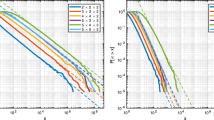Abstract
We define the Polish space R of non-degenerate rank-1 systems. Each non-degenerate rank-1 system can be viewed as a measure-preserving transformation of an atomless, σ-finite measure space and as a homeomorphism of a Cantor space. We completely characterize when two non-degenerate rank-1 systems are topologically isomorphic. We also analyze the complexity of the topological isomorphism relation on R, showing that it is \({F_\sigma }\) as a subset of R× R and bi-reducible to E 0. We also explicitly describe when a non-degenerate rank-1 system is topologically isomorphic to its inverse.
Similar content being viewed by others
References
O. N. Ageev, The generic automorphism of a Lebesgue space is conjugate to a G-extension for any finite abelian group G, Dokl. Akad. Nauk 374 (2000), 439–442.
J. Clemens, Isomorphism of subshifts is a universal countable Borel equivalence relation, Israel J. Math. 170 (2009), 113–123.
J. Clemens, Isomorphism of free G-subflows, manuscript, 2010.
R. Dougherty, S. Jackson, and A. S. Kechris, The structure of hyperfinite Borel equivalence relations, Trans. Amer.Math. Soc. 341 (1994), 193–225.
A. Eremenko and A. Stepin, Non-unique inclusion in a flow and vast centralizer of a generic measure-preserving transformation, Mat. Sb. 195 (2004), 95–108.
S. Ferenczi, Systems of finite rank, Colloq. Math. 73 (1997), 35–65.
A. Fieldsteel, An uncountable family of prime transformations not isomorphic to their inverses, unpublished manuscript.
M. Foreman, D. J. Rudolph, and B. Weiss, The conjugacy problem in ergodic theory, Ann. of Math. (2) 173 (2011), 1529–1586.
M. Foreman and B. Weiss, An anti-classification theorem for ergodic measure preserving transformations, J. Eur. Math. Soc. (JEMS) 6 (2004), 277–292.
S. Gao, S. Jackson, and B. Seward, Group colorings and Bernoulli subflows, Mem. Amer.Math. Soc. 241 (2015), no. 1141.
P. R. Halmos and J. von Neumann, Operator methods in classical mechanics II, Ann. of Math. (2) 43 (1942), 332–350.
A. Hill, Centralizers of rank-one homeomorphisms, Ergodic Theory Dynam. Systems 34 (2014), 543–556.
G. Hjorth, On invariants for measure preserving transformations, Fund. Math. 169 (2001), 51–84.
A. del Junco, M. Rahe, and L. Swanson, Chacon’s automorphism has minimal self joinings, J. Anal. Math. 27 (1980), 276–284.
A. S. Kechris, Classical Descriptive Set Theory, Springer-Verlag, New York, 1995.
J. King, The commutant is the weak closure of the powers, for rank-1 transformations, Ergodic Theory Dynam. Systems 6 (1986), 363–384.
J. King, The generic transformation has roots of all orders, Colloq. Math. 84–85 (2000), 521–547.
J. Melleray and T. Tsankov, Generic representations of abelian groups and extreme amenability, Israel J. Math. 195 (2013), 129–167.
D. Ornstein, Bernoulli shifts with the same entropy are isomorphic, Adv. Math. 4 (1970), 337–352.
D. J. Rudolph, Fundamentals of Measurable Dynamics: Ergodic Theory on Lebesgue Spaces, Oxford University Press, New York, 1990.
T. de la Rue and J. de Sam Lazaro, Une transformation générique peutêtre insérée dans un flot, Ann. Inst. H. Poincaré Probab. Statist. 39 (2003), 121–134.
S. Solecki, Closed subgroups generated by generic measure automorphisms, Ergodic Theory Dynam. Systems 34 (2014), 1011–1017.
S. V. Tikhonov, Embeddings of lattice actions in flows with multidimensional time, Mat. Sb. 197 (2006), 97–132.
Author information
Authors and Affiliations
Corresponding author
Additional information
S. G. acknowledges the US NSF grants DMS-0901853 and DMS-1201290 for the support of his research.
A. H. acknowledges the US NSF grant DMS-0943870 for the support of his research.
Rights and permissions
About this article
Cite this article
Gao, S., Hill, A. Topological isomorphism for rank-1 systems. JAMA 128, 1–49 (2016). https://doi.org/10.1007/s11854-016-0001-4
Received:
Revised:
Published:
Issue Date:
DOI: https://doi.org/10.1007/s11854-016-0001-4



